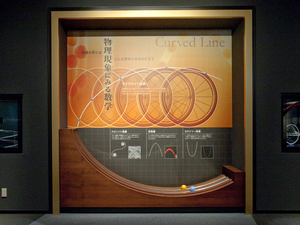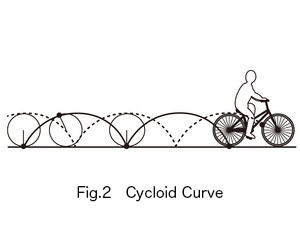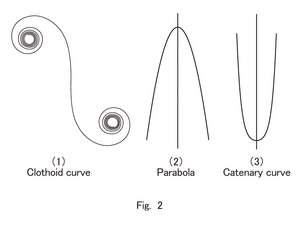Nagoya City Science Museum
TOP > Exhibition Guide > Floor Map> Curved Line
Curved Line



Purpose of Exhibition
There are a variety of curved lines. Circles, parabolas, and hyperbolas are learned primarily in elementary and junior high school. We will introduce several curved lines related to physical phenomena in a variety of curved lines.
Additional Knowledge
[Cycloid Curve]
A Cycloid curve is a curve drawn by a dot forming a circle as it rotates along the straight line. When this curve is turned upside down, it is the form of a slope with a rolling ball in the exhibit. The characteristic of the slope is to be able to reach the lower position from the higher position within the shortest time. Yet, it is conditional that the ball should be in the still position and fall with gravity alone.
Although there are several ways for a slope connecting two dots on the line to create a straight line and curves, the slope, which is a cycloid curve turned upside down, can reach the fastest of all. This curve is called a "Brachistochrone curve". Furthermore, the cycloid curve has a characteristic that helps a ball reach the bottom of the slope at the same speed despite the height.
[Clothoid Curve]
The path that a car makes running at a fixed speed when turning the wheel at the same speed is a clothoid curve. The curve in radius a running car makes becomes big when the wheel is turned slightly at the beginning. Its radius decreases as the wheel turns.
In short, the curve gradually gets sharper. The same thing happens when turning the wheel counterclockwise: the path the car makes forms a clothoid curve. It is natural to turn the wheel at the same speed and turn it counterclockwise when going around a curve by car. If a road is constructed according to the principals of a clothoid curve, the road will be very comfortable to drive.
Suppose that the beginning to the end of the curve of the road is on a fixed curve: in other words, on a part of the circle, you need to make a sudden turn of the wheel up to the angle right after entering the curve. And when driving out of the curve, you need to turn the wheel straight back. It is very dangerous driving.
In many road features, such as ramps leading to highways, the clothoid curve is adopted. Also, the clothoid curve is used in a curve of vertical turn on a roller coaster. If a roller coaster is assembled with simply straight lines and circular arcs, when it enters the circular arc, the passengers on the roller coaster will experience sudden centrifugal force and could be in a dangerous condition.
[Parabola]
A parabola is literally the path of an object when it is thrown into the air. The curve of the water coming up out of a fountain is the parabola. As an object is thrown, it moves horizontally with a fixed speed. When it moves vertically drawn by gravity, the upward speed becomes slow and the object gains downward speed. The line in a high curve drawn by the motion is called a parabola.
This curve is represented in a quadratic equation, y=ax^2, learned at junior high school. (Note)The curved surface of a parabolic dish antenna that catches signals for satellite broadcasting is also a parabola. To be exact, it is a parabolic surface, which is rotated on the axis through the parabola's top. Parabola and parabolic surfaces have characteristics which involve light and electric waves coming parallel to the axis reflected; the parabola and the parabolic surface gather the light and the electric waves at a point. This is how parabolic dish antennas gather electric waves.
[Catenary]
Electric lines between utility poles are loosened by gravity and draw a curve. This "catenary curve" is also created by rope, string, or chain when they are lifted up with both sides grabbed together. Therefore, the curve is also called a pull-up curve. We can see these curves everywhere in our daily life.
Catenary curve is in use with architecture and bridges, since the strength can be put to good use for it.
*(Note) In this article, "x raised to the second power" is indicated as x^2.
Article by Yoshitaka Yamada, curator
